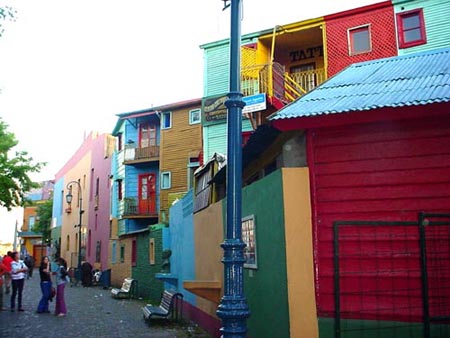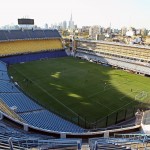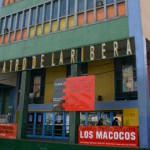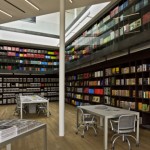ラ・ボカLA BOCA

あるおだやかな日曜日の朝、ブエノスアイレスの近郊の、古くから人気のあるスポットの1つ、ラ・ボカへ出かけた時のこと。It was a sunny Sunday morning when I took a ride to La Boca, one of the most ancient and popular neighborhoods of Buenos Aires. I didn’t really know what to expect, because I used to go there as a child and it wasn’t a pretty landscape for me.子供の頃の記憶では、そこはとても不潔で、騒々しく、そのため、正直あまり期待はしていなかった。そこへ着いた時、そのことが脳裏をよぎったが、しかし、その考えは、すぐに驚くほどきれいな川の前で、消え去り、ロマンティックな景色が目の前に現われた。誰もが川の前で立ち止まり、景色を描く30人程の人達。私にとって、そこはもう以前イメージしていた場所ではなく、とても良い場所となっていた。
![]()
ラ・ボカは、とても多くの歴史を持っている。リアチュエロという小さな川のほとりに位置し、そこは、1880年から1930年にかけて、イタリアやスペインから到着した移民達の避難所であった。そのため、港が建設され、新しいアンゼンチンの住人として、彼らはそこで働きはじめたのだ。
![]()
ミックスカルチャーは、近隣地域へ新しいスタイルを運んでいった。家は、木と金属シートで作られ、壁は港建設で使用し、残ったペンキで塗られた。その美しい明るい色は、この場所を特徴付けるものとなっている。画家達は、写真家以上にこの場所を愛し、毎週日曜には、カミニトという小さな通りで作品を販売している。カミニトは、ラ・ボカの最も象徴的な場所で、観光客が訪れ、音楽とダンスのタンゴを楽しむ場所となっている。
![]()
カミニトには、リノベートされた建物、コンベンティロスが存在する。それらのうちのほとんどはアートギャラリーや、アトリエへとリノベートされた。ブエノスアイレスの前世紀の初めに、失った象徴的な存在である、コンベンティロスは、かつて沢山の部屋を備えた巨大な家であった。そこはまた、タンゴが生まれた場所でもある。タンゴは、もともと売春宿のための音楽として生まれ、居住区に住む労働者にはふさわしくないものとみなされていたが、今日ではとても親しまれている。
![]()
そこにある全てがユニークである、日曜のラ・ボカでは、多くのものを目にすることができる。昼頃には、家族はテーブルに集まり、この地域ならではの“アサド”という肉を食べ、サッカーのテレビ観戦をする。通りでは、あちこちで、素敵な景色を背景に、絵描き達がお互いにポートレートを描きあっている。たまにやって来る旅行者は、道に並べられた絵画、木の家、石の道などすべてを見て回ろうとする。それらすべてを含め、ラ・ボカなのだ。そして最も素敵なことは、 “人がそこに住んでいる”ということだ。
![]()
写真を撮るために、女性が家から出てくるのを待っていると、「ラ・ボカは人々が住んでいる場所なのだ」と、改めて感じた。私が被写体として見ていたカラフルな家々は、人々の住む家なのだ。中には、古くからずっと変わらないままの家もある。
![]()
ちょっと耳を済ましてみると、日曜の食卓を囲み、テレビの前でランチを食べる家族の声が聞こえてくる。おそらく彼らは、この場所を写真撮影したり、観光したりする意義は理解していない。しかし、それだからこそ、この国のカルチャーの代表になのだろう。彼らこそが、本物の“ポルテーニョ”—ブエノスアイレスの住人だ。
![]()
LA BOCA
住所:256 Montes de Oca Avenue, La Boca, Buenos Aires
![]()
Text and Photos: Gisella Natalia Lifchitz
Translation: Naoko Fukushi In fact, I found it dirty, noisy, obscure.
That thought crossed my mind as I was arriving. But it soon disappeared in front of the surprisingly clear river. A romantic view suddenly surrounded me. There was a crowded row of twenty, maybe thirty people, painting their landscape, everyone standing in front of the river. I told to myself it wasn’t the place I had imagined. And that was a good thing.
![]()
La Boca has too much history. It’s situated at the border of the Riachuelo (a small river), and it was a refuge for the immigrants from Italy and Spain, who arrived between the years 1880 and 1930. That’s why the city port was established there, where the new argentine inhabitants worked.
![]()
The mixed cultures brought a particular new physiognomy to the neighborhood. The houses were then made with wood and metal sheet, and the walls were colored with the leftovers of paintings that they obtained at the port.
![]()
The beautiful bright colors are still the main characteristic of this place. Painters love it even more than photographers, and every Sunday many of them work and sell their works of art around Caminito (little road). Caminito is the most precious icon of La Boca, it concentrates the tourist movement and offers alternative “tango” shows with music and dance.
The particular thing about Caminito resides in the restored “conventillos”. Most of them have become open art galleries and renowned painters ateliers. The conventillos, almost a sign of poverty at the beginning of last century in Buenos Aires, were enormous houses with a room for each family. They were, of course, overcrowded. And also one of the places where tango was first heard and danced.
Tango, which was perceived as a marginal musical gender, found in conventillos a place to spread its roots. Even though, tango was born as a music for brothels, not suitable for those decent workers that inhabit the conventillos. Nowadays tango has crossed every frontier and it became a close friend of La Boca.
![]()
You can see many things on a Sunday in La Boca, a synthetically unique neighborhood. The classic family reunion around the table at midday, the “asado” with typical pampas meat, football on TV, lots of painters everywhere portraying each other in front of an imaginary view, the occasional tourists trying to see it all, our popular art on paper, on wooden houses, on the stoned pavement.
La Boca appears to be all of it. And what’s best: people actually live there.
![]()
While I waited for a lady to leave her house before taking a picture of it, I realized La Boca actually exists as a place where people live. The colorful houses we see as an object are inhabited by people.
Some of the houses haven’t even changed a bit from the old days. When one of the neighbors opens the door, we are able to see the long corridor full of closed doors which have inherited who knows what mystery.
![]()
If we listen carefully, we can even hear the family gathered around their Sunday table, prepared to eat lunch in front of the TV. Maybe they don’t understand the purpose of the pictures and sightseeing routines. And perhaps that is why they are some of the most genuine example of our culture. After all, they are a hundred per cent “portenios”.
![]()
LA BOCA
Address: 256 Montes de Oca Avenue, La Boca, Buenos Aires
![]()
Text and Photos: Gisella Natalia LifchitzLA BOCA
地址:256 Montes de Oca Avenue, La Boca, Buenos Aires




